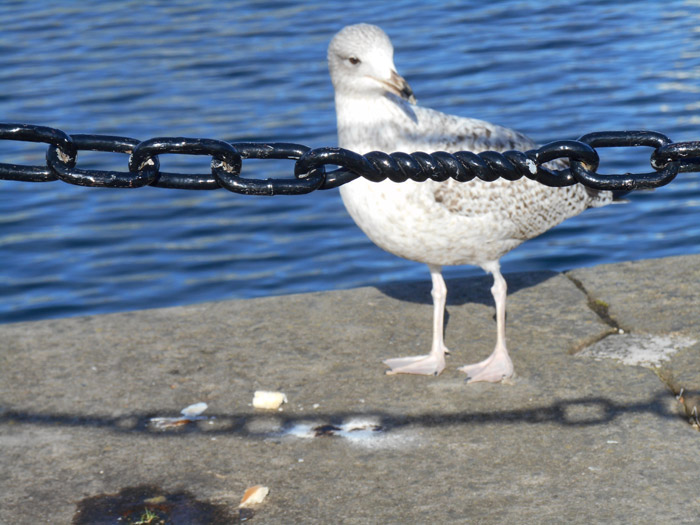
| HOME |
| NERVE |
| REVIEWS |
| ARCHIVE |
| EVENTS |
| LINKS |
| ABOUT US |
| CONTRIBUTORS |
| BACK ISSUES |
| CONTACT US |
Fireweed* - The Struggle for Power and Supplies on the Waterfront
By Sandra
Gibson - March 2015
Photograph by Geoff Edwards
As I walked along the quay of the Albert Dock I noticed piles of broken shards of mussel shells on the paving stones. It surprised me how much liquid was released by these shattered blue-black caskets of edible gold, which had already disappeared down the gullets of gulls. Of course, I had often watched blackbirds using the smash-shell-and-devour-snail technology of avian cuisine but this was the first time I had seen it used by gulls. The delinquent Llandudno gulls of my acquaintance are all on probation for stealing holiday-makers' chips.
Further along, another drama was unfurling in the squally wind. A young gull had several chunks of carbohydrate goodies at his feet, spreading further out each time he pecked at them. Two vigilante pigeons were awaiting their moment to strike but the gull was having none of it. He marched at them every time they approached and the food remained uneaten. Then came an aerial attack from a clutch of black taffeta: Crow Black, the pale shaft of his wing feathers exposed to view in the ruffling breeze, had spotted the picnic and was about to dive. But our gull took off to intercept his plan and chased him off, chased him off, chased him off until he was out of the picture. Then Crow Black swooped back again, only to be chased and chased and chased until he didn't come back.
 |
The air war against the greater enemy having been won, the gull returned to his lunch. But in his absence the lingering pigeons had taken advantage of the diversion in the sky and scoffed the lot, viewed by a distant submariner cormorant, his periscope head on medium alert. Then up he rose from the water to do his show-off flap-flap-flap-flap-flap-flap-flapping before taking off in another direction.
These parables of territory, resources, threat and strategy are not at all far away from human behaviour. I was especially impressed by the vigilant opportunism of the pigeons, whose expenditure of energy was far less than that of the defending gull, the attacking crow or even the spectating cormorant.
Just call me Aesop.
To read other Fireweed columns click here
*Also known as Rose Bay Willow Herb, the prolific wild flower called Fireweed, five feet tall with spikes of magenta flowers, cheers the hearts of those whose cityscape has become a bomb site or whose buildings have been cleared by machine. The dormant seeds spring to life after destructive events such as forest or man-made fires, hence the name, Fireweed. This occasional column will celebrate the persistence of wildlife in urban conditions.